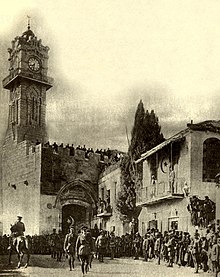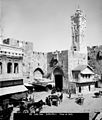Jaffa Gate (Jerusalem)
The Jaffa Gate ( Hebrew שער יפו shaʿar yafo ; Arabic باب الخليل bab al-Chalil , DMG bāb al-Ḫalīl ' Hebron Gate') is one of the eight gates in the city wall of the old city of Jerusalem .
Today's names
Like the Damascus Gate, the Hebrew name is derived from the street connecting Jerusalem with Jaffa , which here leaves the old city as Jaffa Street . In the meantime, however , the New Gate is closer to Jaffa Street. The Arabic name of the gate refers to the way to Bethlehem and on to Hebron (Arabic al-Chalīl ), which also begins at this gate. It has been common since the 16th century; when Jerusalem's western connection to the Mediterranean became more important than the connection to Hebron, the name "Jaffator" came up.
location
The Jaffator is located on the west side of the old city of Jerusalem directly next to the David Citadel and leads from the new city to the Christian and Armenian quarters. The proximity of the citadel shows that this area has always been important for topographical reasons and had to be secured. Because here ran a small pass through which one came from the west between two hills into the Jerusalem city valley and thus into the center.
history
A gate system at this point is first documented in the sources for the early 6th century AD; Theodosius mentions a "tower gate" ( porta Purgu , cf. ancient Greek πύργος pýrgos "tower"). This gate is shown on the Madaba map (around 600). In early Islamic times the gate was called in Arabic Bāb Miḥrab Daʾud "Gate of the prayer niche ( mihrab ) of David", and the David tradition of the gate remained constant even in the time of the Crusaders (Porta David). With the construction of the gate system under Suleyman I , the gate was named Bāb al-Ḫalīl "gate of the friend", which means Abraham / Ibrahim as the friend of God and then Hebron as the city of Abraham. The path through the gate describes a 90 ° curve, which should prevent attackers from breaking quickly through the gate (kink). The dating is attested in inscriptions for the year 945 AH or 1538/39 AD on the outer and inner lintel and on the adjacent city wall.
In the last decades of Ottoman rule, the area in front of the Jaffa Gate developed into an important public space, as this gate was the connection between the old town and the new districts to the west of it. Here was the interface between the old town and the new town. In 1896 the city administration moved to a new quarter on the corner of Mamilla Street and Jaffa Street. Large department stores, banks, hotels and consulates settled in the neighborhood.
In 1898, Sultan Abdülhamid II had today's large gate, which can be passed by cars, built. For the visit of the German Emperor Wilhelm II. To the Ottoman Empire at that time , a small piece of the city wall was torn down in order to fill in the moat surrounding the citadel: a measure necessary because of the car traffic and planned independently of the imperial visit, which Wilhelm II learned, disapproved ("this should be inhibited, I do not hope that such barbarism will really be made"). The reason, however, was Wilhelm II's wish to move through the Jaffa Gate on horseback, which, according to Muslim tradition, only a conqueror was entitled to: As an honorable alternative, the Ottoman authorities created a passage right next to the Jaffa Gate, which Wilhelm II could use for his entry.
In 1906 a large clock tower was built on Jaffa Gate , which, like other clock towers in the Ottoman Empire, symbolized loyalty to the Sultan, combined with openness to progress. As early as 1900, on the occasion of the 25th anniversary of Abdulhamid II's reign, a representative public fountain ( Sabil ) was built on Jaffa Gate .
Under Cemal Pasha, the square in front of the Jaffa Gate was the public space where demonstrations, parades and executions took place. The march through of Ottoman troops on the way to the Egyptian front in December 1914 was staged as a great demonstration of loyalty; Jewish carpenters under the direction of Boris Schatz had erected an “honor gate”. Representatives of the various religious communities and the urban elite gathered at Jaffa Gate to receive the troops. One celebrity hanged on the Jaffa Gate was the Mufti of Gaza, Ahmed ʿAref al-Husayni. Often deserters were hanged on the Jaffa Gate. B. on June 30, 1916 two Jews, two Christians and one Muslim.
When the British general Edmund Allenby entered the city on December 9, 1917, 400 years of Ottoman rule over Jerusalem came to an end, and once again the Jaffa Gate was the backdrop to stage this change of power. Allenby made it important to make his entry into the city in contrast to the visit of Kaiser Wilhelm II. Leaving horses and automobiles behind, he walked through the gate. With this he expressed his respect for the Holy City. On the Jaffa Gate, he was greeted by the military governor and headed a procession of British officers, French, Italian and US representatives, and members of the Picot Mission, which went to the Citadel, where a proclamation in several languages on the future status of Jerusalem was announced.
As governor of Jerusalem, Sir Ronald Storrs had the Ottoman fountain and the clock tower on Jaffa Gate removed in 1921 and 1922.
During the Palestine War , David Shaltiel, as Major General of the Hagana, tried to avert the loss of the embattled Jewish Quarter of the Old City on May 17, 1948 by preparing an attack on the Old City from two sides: a detachment of the Harel Brigade was to conquer Mount Zion and enter the Old City through the Zion Gate ; four platoons of the Etzioni Brigade were to storm the Jaffa Gate. This action turned into a disaster for the Etzioni Brigade. Their attack on the Jaffa Gate was delayed by various difficulties until the evening of May 18, and the Arab side was meanwhile prepared. All the pioneers were killed or wounded before they even reached the gate, and the Etzioni Brigade, under heavy fire, was only busy recovering the wounded from the open space in front of the Jaffa Gate. After all, the failed attack on Jaffa Gate enabled the Harel Brigade to take Mount Zion in a surprise attack. Due to the course of the Green Line after the armistice agreement of 1949 , the Jaffa Gate became inoperable, as the no man's land was connected outside the city wall, a zone that was also secured with barbed wire, land mines and other obstacles from 1962.
literature
- Abigail Jacobson: From Empire to Empire: Jerusalem Between Ottoman and British Rule . Syracuse University Press, New York 2011, ISBN 978-0-8156-3255-9 .
- Max Küchler : Jerusalem. A handbook and study guide to the Holy City . Vandenhoeck & Ruprecht, Göttingen 2007, ISBN 978-3-525-50170-2 .
gallery
Ottoman clock tower on Jaffa Gate
Web links
Individual evidence
- ↑ a b c Max Küchler : Jerusalem. A handbook and study travel guide to the Holy City , Göttingen 2007, p. 115.
- ↑ Abigail Jacobson: From Empire to Empire: Jerusalem Between Ottoman and British Rule , New York 2011, p. 56.
- ↑ Dieter Vieweger , Julia Serr, Marcel Serr: "Archeology is an extremely political business": Kaiser Wilhelm II's journey to Palestine. In: Thorsten Beigel, Sabine Mangold-Will (eds.): Wilhelm II. Und die Archäologie , Stuttgart 2017 , Pp. 31–44, here p. 36 and note 28. ( PDF )
- ↑ Abigail Jacobson: From Empire to Empire: Jerusalem Between Ottoman and British Rule , New York 2011, p. 58 f.
- ↑ Abigail Jacobson: From Empire to Empire: Jerusalem Between Ottoman and British Rule , New York 2011, p. 59 f.
- ↑ a b Abigail Jacobson: From Empire to Empire: Jerusalem Between Ottoman and British Rule , New York 2011, p. 59.
- ↑ Abigail Jacobson: From Empire to Empire: Jerusalem Between Ottoman and British Rule , New York 2011, p. 132.
- ^ J. Bowyer Bell: Besieged: Seven Cities Under Siege . Routledge, New York 2017, p. 224. (Original: Chilton Books, Philadelphia 1966).
- ^ Jon Calame, Esther Charlesworth: Divided Cities: Belfast, Beirut, Jerusalem, Mostar, and Nicosia . University of Pennsylvania Press, Philadelphia 2009, pp. 84 f.
Coordinates: 31 ° 46 ′ 35.8 ″ N , 35 ° 13 ′ 38.7 ″ E







